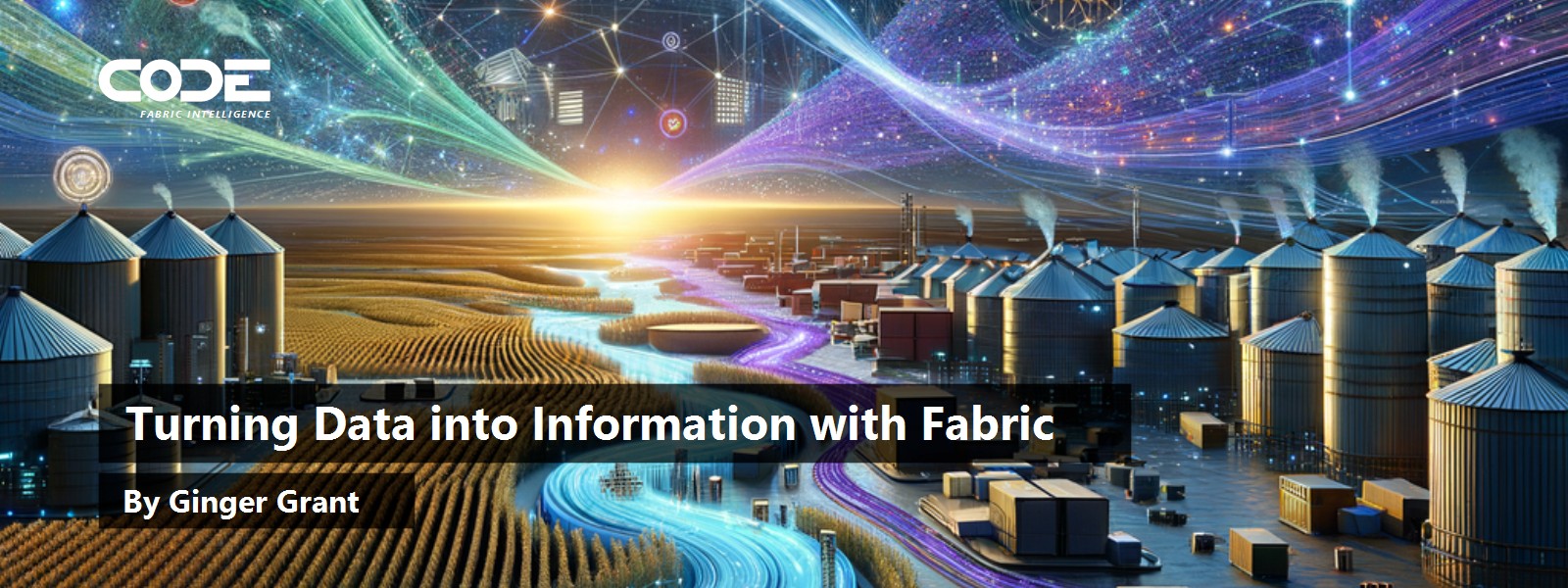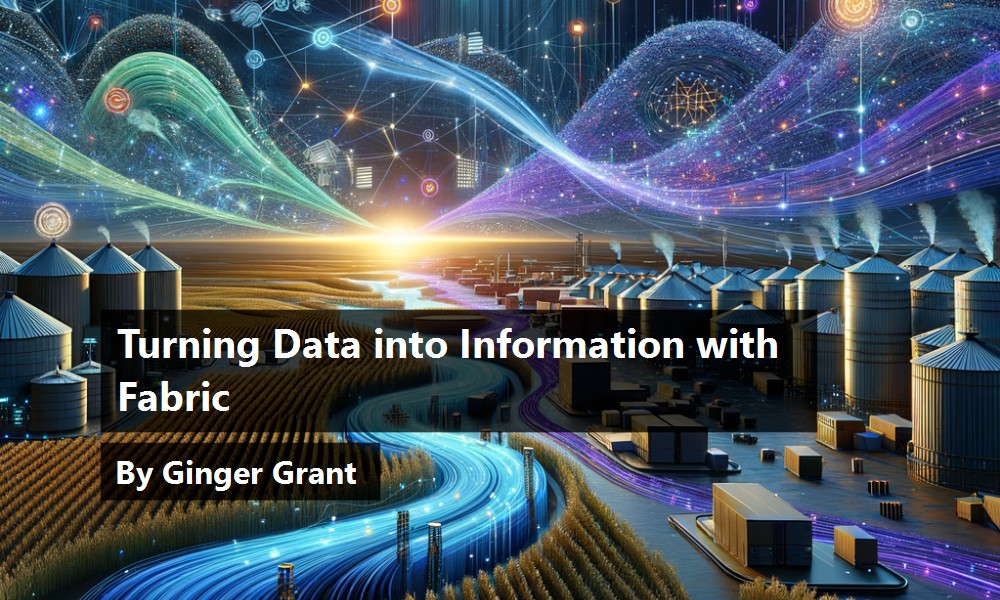


Turning Data into Information with Fabric
by Ginger Grant | July 2, 2025
Organizations use applications which fit the needs for different tasks. If you are tracking customers and helping manage the lead process, your organization may be using a CRM like Microsoft CRM or Salesforce. For managing HR processes, your organization might be using Workday, BambooHR or Gusto. For accounting processes, the organization may be using Dynamics, Xero or FreshBooks or other applications that were developed internally to solve a business need. Most likely, your data is stored in different silos. Also, there is a good chance that data in Access, Excel or SharePoint might be critical to track some aspects of business functionality. To provide a holistic view of the data requires combing all those different elements together and providing an analytical environment for reporting. This can be a complicated process as data needs to be extracted from different systems and sources and stored together, then transformed. The system needs to be scalable and support diverse needs you may have with the data.
To provide a holistic view of the data requires combing all those different elements together and providing an analytical environment for reporting.
Microsoft looked at the different solutions they were providing to solve this problem and realized that their tools designed to do this could be improved. They created an innovative approach to help solve this problem, Microsoft Fabric.
Data by Itself Is Not Information
If you are looking to analyze what is going on in all the applications used for the entire organization, you might have many systems to consider. Ideally the data should be gathered in one place so that everyone who needs data can access it. I wrote about the desire for organizations to bring data together to find a single version of the truth in my last blog.
When organizations recognize the data silo problem that they have and they understand that previous constraints like expensive storage aren't as prohibitive as they were in the past, they can consider tools like Microsoft Fabric to bring their data together for analysis
Naturally a robust and centrally managed security system designed by the organization needs to be in place. And if you want to do analytics over all of it, the data will need to be structured in a way that makes analytics easy to do in reporting tools like Power BI. This problem is one many organizations are having. Data is everywhere, but information? Well, that may be lacking. Information drives data-driven decisions—that's why we keep data: to get answers. For your data to provide answers, a system which manages and collects all of it is required, instead of pursuing the myriad of ways each provider wants you to do manage their data.
Bringing Data from Different Apps Together in OneLake
When looking at this problem, Microsoft realized that they needed to bring this data together. Data existing in silos wasn't helping companies solve problems, so they created a storage location for everything called OneLake. It is meant to be a unified data lake, and the one place where companies can store all of their data. It can manage all different types of data, including images, sound, and of course text-based data, but also organize and structure it in a way that provides value. Storing data has become a lot less expensive than in the past and storing data in Fabric costs about $23 dollars a month for a terabyte of data storage. The cost for compute is separate, and there are a number of different hourly, monthly, or yearly price points available. The big change is you can easily scale up or down to use the compute you need or turn it off if you don't need anything on a given day.
When organizations recognize the data silo problem that they have and they understand that previous constraints like expensive storage aren't as prohibitive as they were in the past, they can consider tools like Microsoft Fabric to bring their data together for analysis.
How to Get Data Into Microsoft Fabric: Shortcuts, Mirroring and Direct Ingestion
Using Data from Different Systems with Shortcuts
Microsoft also knew that companies have data stored in existing areas such as Google Big Query or AWS Redshift, which may already be structured, and they might not need to copy it; they might want to just reference the data and use the existing systems to update it. Shortcuts provide the ability to just link to an existing storage location. There is no need to build processes to copy the data; you can store the data securely without any need to duplicate it if shortcuts can link to where it already exists. If you have data stored perhaps in Azure ADLS Gen2 and the data changes, the shortcut doesn't need to be changed. OneLake contains a link to the new data so there is no need to waste processing cycles on updating it as the shortcut will provide access to the data in near real time.
Mirroring: Real-time Copy of the Database
Often companies want to be able to report on data as soon as it is available. One solution for this is to implement streaming, but another solution is to include a copy of the database used in an application which will be stored in OneLake. This way, as soon as updates are made to the database, the changes can be reported on in real time. This is different than creating a shortcut to a file or set of files as you may wish to use the entire database for real time analysis or reporting. As building and maintaining processes to copy data from one database to Fabric can be time consuming, Microsoft is working on eliminating the need to build, extract and load processes by developing a feature known as database mirroring.
If the data is stored in an Azure database or Snowflake DW, Microsoft included a feature to include a copy of the database inside of Fabric using a feature called mirroring. This means that if someone updated the database indicating, for example, that ten new orders were placed, that new piece of data could instantly be included in a part of a report when the database was mirrored. Currently, the ability to create a mirror of a SQL Server Database not in the cloud. to Fabric is being previewed, which allows a current copy of the database to be added to Fabric, and when this is released customers will not have to migrate any data from their local databases to Fabric as the mirror will provide a read only copy, as it does now for Snowflake. Microsoft announced at the 2025 Microsoft Fabric Community Conference that they hope to bring the capability to mirror more databases, including Oracle, to Fabric soon so that the mirroring functionality can continue to grow to encompass all data stored in databases to be in Fabric.
Organizing the Data for Reporting in a Lakehouse or Warehouse
Once the data is included in OneLake it is much easier for data engineers to build a lakehouse or warehouse to provide that single version of the truth in data. These two different data structures both provide the ability to store terabytes of data in a database format, but the features provided are a little different. With a data warehouse you can use T-SQL to load and update data. In a lakehouse you use PySpark code to add and modify the data. Having two different storage elements for data provides the ability to support different needs organizations may have. Organizations can create their own methods to access and secure the data, rather than relying on several different third-party applications to restrict data as they see fit. Data security models are created inside of the lakehouse or warehouse to restrict access to parts of the data to different groups of users based on Entra security groups, the name Microsoft is now using for Azure Active directory groups. The security is similar to what is currently provided in SQL Server and is implemented using roles and permissions created in the lakehouse or warehouse. The data is available for many different kinds of analysis too. Data Scientists can build their own models on the data and extract the elements they need to answer questions with machine learning. Analytical models containing all of the data that a business has gathered can be created for Power BI reporting or ad hoc querying. In keeping with the desire to eliminate the need to create transformational pipelines, Power BI can directly connect to a lakehouse or warehouse and use that data without needing to build a separate refresh process, meaning changes are automatically propagated in a process known as Direct Lake.
Once the data is included in OneLake it is much easier for data engineers to build a lakehouse or warehouse to provide that single version of the truth in data.
When data does need to be transformed into a star schema, which is the common format used in analysis in Power BI, Microsoft provides both low code and industry standard open-source solutions with PySpark. By providing both low code and open-source coding options, Fabric provides paths to support existing code and easily incorporate data from companies without a deep technical bench. In addition, developers who want to use the same open-source methodologies they may have used in other tools can build data transformation processes with Spark, with or without the assistance of AI. Microsoft has built-in support for Copilot, either by using the Fabric application or the developer's favorite, GitHub Copilot in VS Code.
Incorporating Existing Tools in Fabric
Microsoft also has built in interoperability with their other tools such as SQL Server Management Studio, which can be used to query a lakehouse, data warehouse or even a Power BI semantic model. As you might expect, Microsoft makes connecting and using data in Fabric easy to do in Power BI, and they continue to provide features, such as the ability to have AI by having Copilot generate your Power BI reports using Fabric. And of course, Microsoft supports the ability to directly access data in the tool most widely used by business analysts, Excel. You can directly and securely connect to data stored in Fabric using Excel, providing users with the ability to analyze data using pivot tables, without the need for time consuming processes to refresh data.
As organizations grow and change to adapt to changing elements in the world around them, they will continue to store data from the applications they are using now and can be ready to add new ones as the business needs change. With Microsoft Fabric, organizations are ready to meet new demands as the method for storing and analyzing that data for now and for the future using OneLake for storage and the different tools inside of Microsoft Fabric to organize and provide information through database queries, Power BI or Excel in order to be able to deliver on the goal of one version of the truth to answer questions over all the data.
